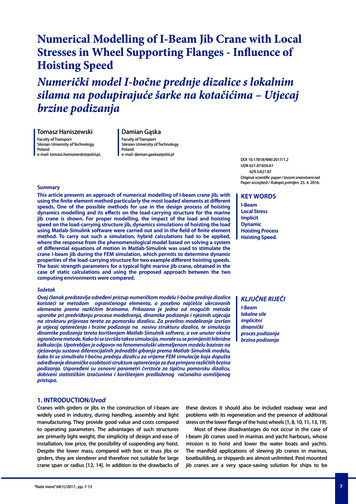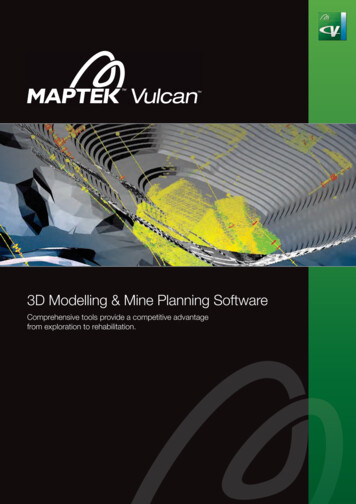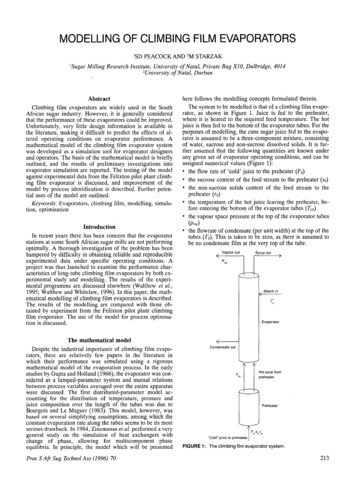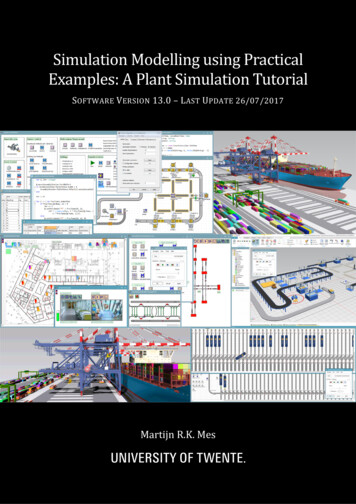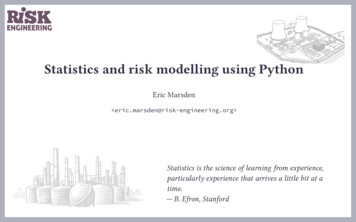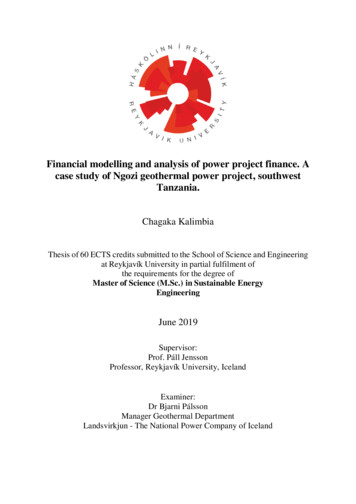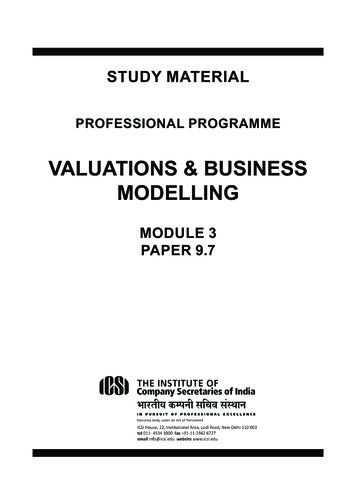
Transcription
STUDY MATERIALPROFESSIONAL PROGRAMMEVALUATIONS & BUSINESSMODELLINGMODULE 3PAPER 9.7i
THE INSTITUTE OF COMPANY SECRETARIES OF INDIATIMING OF HEADQUARTERSMonday to FridayOffice Timings – 9.00 A.M. to 5.30 P.M.Public Dealing TimingsWithout financial transactions – 9.30 A.M. to 5.00 P.M.With financial transactions – 9.30 A.M. to 4.00 si.eduE-mailinfo@icsi.eduLaser Typesetting by AArushi Graphics, Prashant Vihar, New Delhi, andPrinted at M P Printers/November 2018ii
PROFESSIONAL PROGRAMMEVALUATIONS & BUSINESS MODELLINGA business valuation provides the management of business with numerous facts and figures pertaining to theactual worth or value of the company in terms of market competition, asset values and income values. The keybenefits of business valuation are: Better Knowledge of Company Assets; Understanding of Company ResaleValue; Assistance during Merger & Acquisitions; Obtain a True Company Value and Access to More Investors.With the surge in business activities, valuations have occupied the centre stage. Whether it is a start-up or a bigcorporate house, valuations is pervasive. Right from the setting up of the business entity, during its merger andacquisitions, for obtaining long-term finance from banks / financial institutions, winding-up and for various otherbusiness purposes, valuation is an integral component. There are various vital dimensions associated with thevaluation- International Valuation Standards; Guidance to Valuation; Methods used in Valuation; Valuation ofTangibles and Intangibles; Valuation during Mergers & Acquisitions etc. In order to have a holistic approach onvaluation and to surmount over valuation related matters, it is extremely essential that a professional needs tobe conversant with the aforesaid elements of valuation.Merely possessing the theoretical knowledge on the subject will not suffice as it is like a applied researchwherein every element of valuation has a practical relevance. Moreover, depending on the magnitude, natureand scale of the business different valuation approaches needs to be embraced.Another concept that has gained steam is Business Modelling. Despite presence of various resources, i.e.finance, human, material, technology etc. in abundance if the business organisation is devoid of a robustbusiness model then either it may not attain the desired level of performance or collapse during turbulence.Perhaps financial giants like Lehman Brothers and other investment banks would not have collapsed due to theonslaught of global economic crisis had they were having sound business models.Business models to be sustainable needs to be revised in light of the changing legal, business and economicenvironment. It needs to be developed by using scientific approach rather than rule of thumb. Approaches like,spreadsheet techniques, future projections, analysis of key financial ratios, cash flow analysis, estimation ofmaximum finance required, working capital management etc. may assist immensely in building a robust andsustainable business model.Company Secretary Profession have witnessed a drastic metamorphosis. From a ‘Glorified Clerk’, they haveattained the status of ‘Governance Professionals’. In other words, the trajectory of the Company SecretaryProfession have moved upward when one compares his / her role under Indian Companies Act, 1956 andIndian Companies Act, 2013. Without an iota of doubt it can be opined that Indian Companies Act, 2013 havebeen a game changer for the Company Secretaries.Since the role of a Company Secretary in the capacity of a ‘Registered Valuer’ has been duly recognized underthe Companies Act, 2013, consequently, it has added wings to the profession. An in-depth knowledge of thesubject will definitely assist a Company Secretary-in-Making to explore career opportunities in the areas ofValuations and Business Modelling.Days are gone when technical areas like valuation and business modelling were the forte of selected groupof experts. Today, a Company Secretary is competent enough to undertake valuation related activities. In theera which is marked by soaring merger and acquisitions, particularly, cross-border merger and acquisitions, aiii
comprehensive knowledge of the subject will play a pivotal role in understanding the finer aspects of mergerand acquisitions, like valuation of tangibles, valuation of intangibles etc. Similarly during winding-up process,there is a need for valuation of various assets and in absence of proper understanding on the key concepts ofvaluation, it will be next to impossible for a Company Secretary to execute the valuation process.Any business be it of any magnitude, it can only attain excellence, when it is sustainable. For a business tobe sustainable it needs a robust business model. Like on the rails the train runs and if the rails are of abysmalquality then there is a probability of derailment, similarly, if a company does not have a sound business model,then in the long run, the survival of the company may be difficult.Further, in this dynamic business eon, where only constant thing is change, it is extremely important thatbusiness organizations change or develop new business models as and when the need arises. For instance, ifa company is operating in an industry which is having an oligopoly form of market competition and due to entryof more firms, it transforms into monopolistic form of market competition, then the business organization mayhave to either change or start from the scratch its business model.A Company Secretary being the ‘Key Managerial Personnel’ of the company and being an indispensablehuman capital of the company, it is essential that he / she must possess deep insights regarding various formsof business models, factors determining a robust business model, MS-Excel applications of various financefunctions etc.In view of the aforesaid matter, this subject will act as a ‘Lighthouse’ in guiding the Company Secretaries whileperforming valuation and business modelling related activities.Although due care has been taken in publishing this study material, yet the possibility of errors, omissionsand/ or discrepancies cannot be ruled out. This publication is released with an understanding that theInstitute shall not be responsible for any errors, omissions and/or discrepancies or any action taken in thatbehalf. Should there be any discrepancy, error or omission noted in the study material, the Institute shallbe obliged if the same are brought to its notice for issue of corrigendum in the e-bulletin Student CompanySecretary. In the event of any doubt, students may write to the Directorate of Academics in the Institute forclarification at academics@icsi.edu.There is open book examination for this Elective Subject of Professional Programme. This is to inculcate anddevelop skills of creative thinking, problem solving and decision making amongst students of its professionalprogramme and to assess their analytical ability, real understanding of facts and concepts and mastery to apply,rather than to simply recall, replicate and reproduce concepts and principles in the examination.iv
PROFESSIONAL PROGRAMMEMODULE 3ELECTIVE PAPER 9.7VALUATIONS & BUSINESS MODELLING (MAX MARKS 100)SYLLABUSObjectivesPart I : To develop a reservoir of knowledge on valuation which can assist the Company Secretaries inundertaking valuation assignments as a Registered Valuer under Companies Act, 2013 including forMergers and Acquisitions, Issue of Shares, Winding up of Business and during Distressed Sale.Part II : To assist the student in comprehending the concept of Business Modelling, its vital components,steps involved in preparation of a Business Model and Business Models for varied magnitude ofbusiness organizations.PART 1: VALUATIONS (70 MARKS)Detailed Contents1.Overview of Business Valuation : Genesis of Valuation; Need for Valuation; Hindrances/ Bottlenecksin Valuation; Business Valuation Approaches; Principles of Valuation (Cost, Price and Value).2.Purpose of Valuation : M&A, Sale of Business, Fund Raising, Voluntary Assessment; Taxation;Finance; Accounting; Industry perspective; Statutory Dimension; Society Angle.3.International Valuation Standards Overview.4.Valuation guidance resources in India.5.Business Valuation Methods: Discounted Cash Flow Analysis (DCF); Comparable transactionsmethod; Comparable Market Multiples method; Market Valuation; Economic Value Added Approach;Free Cash Flow to Equity; Dividend Discount Model; Net Asset Valuation; Relative Valuation; Overviewof Option Pricing Valuations.6.Steps to establish the Business Worth: Planning and Data Collection; Data Analysis and Valuationincluding review and analysis of Financial Statements; Industry Analysis; Selecting the BusinessValuation Methods; Applying the selected Valuation Methods; Reaching the Business Value Conclusion.7.Valuation of Tangibles: Overview of Valuation of Immovable Properties; Plant & Machinery;Equipments; Vehicles; Capital Workin-Progress; Industrial Plots; Land and Buildings; Vessels, Ships,Barges etc.8.Valuation of Intangibles: Definition of Intangible Assets; Categorization of Intangibles- MarketingRelated (Trademarks, Trade names, Certification marks, Internet domains etc.), Customer or SupplierRelated (Advertising Agreements, Licensing, Royalty Agreements, Servicing Contracts, FranchiseAgreements), Technology Related (Contractual or non-contractual rights to use: Patented or UnpatentedTechnologies, Data Bases, Formulae, Designs, Softwares, Process), Artistic Related (Royalties fromartistic works: Plays, Books, Films, Music).9.Accounting for share based payment (Ind AS102).v
10.Valuation during Mergers & Acquisitions.11.Valuation of various magnitudes of Business Organizations: Large Companies, Small Companies,Start-Ups, Micro Small and Medium Enterprises.12.Valuation of Business during Distressed Sale.PART- II: BUSINESS MODELLING (30 MARKS)13.Introduction to Business Modelling : Genesis, Meaning; Features; Significance; Usage; SpreadsheetTechniques (Effective use of spreadsheets for modelling, Review of key Excel Functions like buildingMacros, Decisions involving Time Value of Money); Report and analyze historical data, Prepare futureprojections and present integrated financial statements, Key financial ratios and Outputs in a logical,summarized and effective manner.14.Business Model Analysis: Facets of Analysis : Revenues: Cash flows and their timing and Revenuedrivers, Expenses: Cash flows and their timing, Investment required through cash flow breakeven:Working Capital, Maximum financing required and cash flow breakeven timing, Sensitivity Analysis:Key success factors, Structuring and designing models.vi
LESSON WISE SUMMARYVALUATIONS & BUSINESS MODELLINGLesson 1: Overview of Business ValuationValuation has gained paramount significance in business arena. With the evolution of various forms of businessorganizations, especially, company form of business organization, valuation has occupied the centre stage.Valuation has become pervasive, i.e. whether during commencement of business, expansion, merger andacquisitions, winding-up etc. valuation are imperative. This study lesson has made an endeavour to throw lighton crucial elements of business valuation- Genesis of Valuation; Need for Valuation; Hindrances in Valuation;Business Valuation Approaches etc. After reading this lesson the reader will be conversant with fundamentalsof valuation.Lesson 2: Purpose of ValuationValuation is applicable to various business events, i.e. mergers and acquisitions, sale of business, procurementof funds, taxation etc. Unless and until the key managerial personnel are thorough with the valuation processesinvolved in the mentioned business events, it will be extremely difficult for them to discharge their professionalobligations. Further, various business events demand a different approach of valuation.This lesson have made an attempt to encompass the critical concepts whose understanding is needed toexecute the assignments relating to mergers and acquisitions, convincing banks and financial institutions atthe time of raising finance to meet working capital and long-term capital requirements, handle taxation relatedmatters, to meet various statutory requirements etc.Lesson 3: International Valuation Standards OverviewLike accounting standards, international valuation standards are also an integral component of businesstransactions. A comprehensive knowledge of international valuation standards is needed for undertakingvaluation assignments requiring generally recognized concepts and principles that foster transparencyand consistency in valuation process. Along with other important concepts, the critical areas, i.e. bases ofvalue and valuation approaches and methods which are like a fulcrum of valuation process have been dulyfocused upon.In view of this, this lesson has focussed on three dimensions – International Valuation Standard (IVS) framework,International Valuation Standard (IVS): General Standards and International Valuation Standard (IVS): AssetStandard.Lesson 4: Valuation Guidance Resources in IndiaValuation activities have engulfed almost all the sectors of Indian economy. Be it Power, Banking and FinancialServices, Steel, Coal, Cement, Fertilizer, Textile etc. valuation has entered their DNA. Most of the companies invarious sectors are going for mergers and acquisitions, expansion, diversification as well as winding-up and allthese business activities cannot be imagined without valuation.Quite recently the innovative business concept of Start-ups have gained steam and so their valuation. Further,valuation of public sector enterprises has also gained prominence, especially after disinvestment of publicsector enterprises. Thus, this lesson has delved deep into various Indian Valuation Standards.vii
Lesson 5: Business Valuation MethodsMere theoretical knowledge about valuation is not sufficient. A professional or senior management officialundertaking valuation process needs to be acquainted with various methods used in valuation. Keeping thispertinent point in view, this lesson have covered various business valuation methods, like, Discounted CashFlow Analysis (DCF); Comparable Transactions Method; Comparable Market Multiples Method; EconomicValue Added Approach; Free Cash Flow to Equity etc.Since various methods are applied depending upon the sector to which a company belongs to, economic,business and legal scenario, events giving rise to valuation etc. a complete understanding of various businessvaluation methods is a must.Lesson 6: Steps to Establish the Business WorthHow to establish the value of a business is a million dollar question. Establishing of business worth involveseveral factors, like, planning and data collection, data analysis including analysis of financial statements,industry analysis, choosing the appropriate business valuation methods etc. Further, each factor requires robustunderstanding as all the factors are interlinked.Since how much a business is worth is a fundamental issue in valuation, in view of this, the lesson has coveredvarious practical aspects pertaining to establishing of business worth.Lesson 7: Valuation of TangiblesTangible assets are key to business operations. Whether an organization is engaged in production of goodsor services, tangibles occupy a significant place. In absence of tangible assets it will be impossible to performproduction and trading of goods or services. There are various facets of tangible assets, like cost / value,methods of valuation of tangible assets etc. These and other critical facets associated with valuation of tangibleshave been taken into account. Due emphasis have been given on valuation of certain important tangibles like,Real Estate, Plant & Machinery, Vehicles and Ships & Barges.Lesson 8: Valuation of IntangiblesValuation involves analysis of a company and so intangible assets cannot be ignored. Various intangible assetslike, trademark, certification marks, designs etc. are considered as important assets since they assist immenselyin enhancing sale of the business. It can be said without an iota of doubt that brands, technologies, formulae,softwares etc. are crucial to company’s success. Keeping this vital point in view, this lesson has focused uponalmost all forms of intangible assets.Lesson 9: Accounting for Share Based Payment (Ind AS 102)Indian Accounting Standard acts as a lighthouse for the companies in treatment of various business transactions.In this regard, one of the crucial financial treatments pertains to share based payment. Ind AS 102 prescribesfinancial reporting in respect of share-based benefits and is relevant for companies which remunerate theiremployees by share-based (or stock option) schemes, such as Employee Stock Options (ESOP), ShareAppreciation Rights (SAR), Phantom Equity, Share Purchase Plans (SPP) etc.This lesson have given emphasis on equity-settled share based payment transactions, transactions inwhich services are received, hurdles or bottlenecks in evaluation of the fair value of the equity instrumentsetc.Lesson 10: Valuation during Mergers & AcquisitionsMergers and acquisitions have become a buzzword in business scenario. Now a day most of the sectors arewitnessing merger and acquisitions. It is a complex process and valuation plays a pivotal role in it. Valuationviii
of the target company involves several critical processes. Depending on the scale of operations and nature ofbusiness of the target company the valuation approach needs to be chosen.This lesson has touched upon various significant concepts pertaining to mergers and acquisitions- Types ofvalues, M &A strategy, Theories of Merger & Acquisitions, Methods used in valuing the target company etc.Lesson 11: Valuation of Various Magnitudes of Business OrganizationsThere are various forms of business organizations operating in varying scales. But valuation is omnipresent andso irrespective of the size of the business organization it is used. Keeping in view it’s applicability for variousmagnitudes of business organizations, this lesson has covered the valuation of large companies, privatecompanies, start-ups and micro, small and medium enterprises.Lesson 12: Valuation of Business during Distressed SaleWith the evolution and growth of business organizations, winding-up have also become a common phenomenon.Several corporate houses which even after embracing corporate restructuring failed to revive the business areleft with no option other than distressed sale of business. Firms in financial distress cannot meet, or havedifficulty paying off their financial commitments to their creditors, typically due to high fixed costs, illiquid assetsor revenues that are sensitive to economic downturns.It is critical to identify the nature of distress. The optimal course of action for companies facing irreversibleeconomic distress is liquidation of assets. But sale involves valuation of the business. No doubt, there arevarious valuation methods to gauge the value of the business but at times of distress the valuation is altogethera different ball game.Lesson 13: Introduction to Business ModellingBusiness models provide the trajectory to the business activities. In absence of a robust business model, the bestbusiness organizations may also witness an untimely collapse. Further, while developing a business model, thefollowing vital facts needs to be at the focal point- Diversity, Modularity, Openness, Slack resources, Matchingcycles, Identify your specific audience, Establish business processes, Develop a strong value proposition,Determine key business partners and Leave room for innovation.In view of the paramount significance business modelling holds, this lesson have focused on critical topics,i.e. various forms of business models, significance of business modelling and process involved in buildingspreadsheet based decision model.Lesson 14: Business Model AnalysisMerely construction of a business model will not suffice. It is just the first step. Going further, a business modelneeds to be analysed from various angles. For instance, if a business model fails to generate adequate revenueor cash flows from a project then it cannot be termed as an ideal business model.Thus, keeping in view the significance of business model analysis, this lesson has focused upon importantdimensions, like, Dynamic and Non-dynamic aspects of business models, Timing of cash flows and RevenueDrivers, Working capital management, Maximum finance required, Sensitivity analysis etc.ix
LIST OF RECOMMENDED BOOKSPaper 9.7: Valuations & Business Modelling1)McKinsey & Company:Valuation: Measuring and Managing the Value.2)Aswath Damodara:The Little Book of Valuation: How to Value a Company, Pick a Stockand Profit.3)Registered Valuers:Study Material for Educational Course- Asset class: Organisation(A wholly Securities or Financial Assets. owned subsidiary of ICSIand registered with IBBI)4)David Parker:International Valuation Standards: A Guide to the Valuation of RealProperty Assets.5)Kamal Garg:Valuation by Registered Valuers under Companies Act, 2013 &Insolvency & Bankruptcy Code, 2016.6)D.N.Banerjee:Principles and Practice of Valuation7)McKinsey & Co.:Valuation measuring value of Companies8)Benjamin Graham:The Intelligent Investor9)Krishna Palepu:Business Analysis and Valuation10)Stanley Feldman:Principles of Private Firm Valuation11)David Parker:International Valuation Standards: A Guide to the Valuation of RealProperty12)Blair Macdonald:Business Valuations- A Guide to Business Valuation13) Graham Friend andJohn Tennent:Guide to Business Modelling14)Bob Vause:Guide to Analysing Companies.15)Corporate Professionals : Business Valuation in India – Beyond the Numbers (2018)Journals1. e-Bulletin:(Student Company Secretary):The ICSI, New Delhi2.RVO ConnectNewsletter for Valuation Professionals.3.Chartered Secretary (Monthly) :The ICSI, New Delhi4.Vikalp:IIM Ahemadabad5.Decision:IIM CalcuttaNote:1. Students are advised to read the above journals for updating the knowledge.2. Students are advised to read/refer the latest editions of the recommended books.x
ARRANGEMENT OF STUDY LESSONModule-3 Paper-9.7VALUATIONS & BUSINESS MODELLINGSr. No.Lesson TitlePart I- Valuations (70 Marks)1.Overview of Business Valuation2.Purpose of Valuation3.International Valuation Standards Overview4.Valuation Guidance Resources in India5.Business Valuation Methods6.Steps to Establish the Business Worth7.Valuation of Tangibles8.Valuation of Intangibles9.Accounting for Share based Payment (IND AS 102)10.Valuation during Mergers & Acquisitions11.Valuation of various Magnitudes of Business Organizations12.Valuation of Business during Distressed Sale.Part II- Business Modelling (30 Marks)13.Introduction to Business Modelling14.Business Model Analysisxi
CONTENTSLESSON 1OVERVIEW OF BUSINESS VALUATIONOrientation2Family Tree of Concepts2Introduction2Genesis of Valuation3Industrial Revolution of England and France5Industrial Revolution in India6Significance of Valuation in M&A Process6Need for Valuation6Purpose of Valuation: Indian considerations10Various Expression of Value10Fair Value11Book Value11Intrinsic Value12Replacement Value12Liquidation Value12Going Concern Value13Equity Interest Value13Caselet of Equity Interest Value13Insurable Value14Value-in-use and Value-in-exchange14Salvage Value15Relationship Among Different Types of Value15Purposes of Valuation and Impacts on the Value Estimates16Price and Value Differentiation17Hinderances / Bottlenecks in Valuation18Business Valuation Approaches18Case Study27Principles of Valuation29Sources of Information for Valuation30xii
SUMMARY30SELF TEST QUESTIONS32LESSON 2PURPOSE OF VALUATIONOrientation36Family Tree of Concepts36Introduction37Business Valuation Purposes37Mergers & Acquisition38Purpose of Valuation in Merger & Acquisition41Case Study 1: Sun Pharmaceuticals acquires Ranbaxy:44Case Study 2: CMC merges with TCS:45Sale of a Business45Purpose of Valuation in Sale of Business46Fund Raising49Purpose of Valuation in Fund Raising52Voluntary Assessment54Tax Valuation54Finance55Usage56Accounting56Examples of Valuation Accounts57Industry Perspective57Statutory Dimension58Statutory purposes of valuations (Section 6)59Society Angle59SUMMARY60SELF TEST QUESTIONS61LESSON 3INTERNATIONAL VALUATION STANDARDS OVERVIEWOrientation64Family Tree of Concepts64Introduction64xiii
Arrangements of IVS65Compliance with Standards66Assets and rtures67IVS General Standards68IVS 102 Investigations and Compliance70IVS 103 Reporting71IVS 104 Bases Of Value72IVS Defined Basis of Value73IVS 105 Valuation Approaches and Methods76Market Approach77Market Approach Methods77Other Market Approach Considerations79Income Approach79Income Approach Methods79Gordon Growth Model / Constant Growth Model80Reason for choice of methodology adopted under the Income Approach81Cost Approach81Asset Standards82IVS 200 Businesses and Business Interests83IVS 210 Intangible Assets83IVS 300 Plant and Equipment85IVS 400 Real Property Interests87IVS 410 Development Property88Case Study89IVS 500 Financial Instruments90Case Study91Indian Valuation Standards (IVSs) issued by ICAI92Applicability of Indian Valuation Standards93SUMMARY93SELF TEST QUESTIONS94xiv
LESSON 4VALUATION GUIDANCE RESOURCES IN INDIAOrientation98Family Tree of Concepts98Introduction98Guidance for Valuation of Public Sector Undertakings100Valuation Methods for Indian Market105Start-up Valuations106Real Estate Valuations107Income method108Cost Method112Caselet based on Cost method113Residual Method113Caselet based on Residual Method115Discounted Cash Flow Method117Caselet based on Discounted Cash Flow Method117Profits Method118Indian Valuation Standards119SUMMARY126SELF TEST QUESTIONS127LESSON 5BUSINESS VALUATION METHODSOrientation130Family Tree of Concepts130Introduction131Meaning of Business Valuation131Areas where valuation is required132Valuation Perspectives132Case Study 1134Business Valuation Methods136Case Study 2142Other Methods of Valuation142Overview of Option Pricing Valuations146xv
Effect Of Valuation By Experts149Summary of Valuation Report151The International Valuation Standards Council153Case Study 3154SUMMARY163SELF TEST QUESTIONS163LESSON 6STEPS TO ESTABLISH THE BUSINESS WORTHOrientation166Family Tree of Concepts166Introduction166How a Business Valuation Helps Company Owners Avoid Guesswork166From Fair Market Value to Book Value167Steps to Establish Business Worth167Step 1: Planning and Preparation167Business valuation depends on how business value is defined168Business facts that affects business value169Step 2: Adjusting the Historical Financial Statements169Step 3: Choosing the Business Valuation Methods171Step 4: Number Crunching: Applying the Selected Business Valuation Methods175Step 5: Reaching the Business Value Conclusion177Step 6: Number Crunching: Applying the Selected Business Valuation Methods183Step 7: Reaching the Business Value Conclusion185SUMMARY185SELF TEST QUESTIONS186LESSON 7VALUATION OF TANGIBLESOrientation190Family Tree of Concepts190Introduction190Concept of “Value” & “Valuation190Valuation in context of the “Goal” of Financial Management193Valuation Approaches194xvi
Income Approach194Cost Approach199Advantages & Disadvantages of Cost and Sales Comparison Approaches204Accounting Treatment of Assets under IFRS204Key Features of IAS 16 – Property, Plant & Equipment205Recognition (16.7)205Initial Measurement206Measurements subsequent to Initial Recognition206Impairment Testing206Valuation or Re-valuation disclosures207Importance of Valuation of Tangible Assets by reference to IAS 16207Key Features of IAS 36 – Impairment of Assets207Indicators for Impairment208Recoverable Value209Value in Use209When measuring VIU, the entity’s cash flow projections209Fair Value less Costs to Sell210Disclosures211Importance of Valuation of Tangible Assets by reference to IAS 36211Valuation of Plant & Machinery211Valuation of Vehicles214Valuation of Ships & Barges215Reasons for Valuations215Market Characteristics216Fees217Method217Willing Buyer, Willing Seller218Quantitative Factors218Qualitative Factors218Specific Factors219Earnings219Demolition and Newbuilding219Fleet Valuations219Art or Science220xvii
Guidelines for Banks220Guidelines for Valuers220SUMMARY222SELF-TEST QUESTIONS222LESSON 8VALUATION OF INTANGIBLESOrientation226Family Tree of Concepts226Introduction226Marketing Related Intangible Assets228Trademark228Facets and Strengths of Trademarks229Duration and Registration of a Trademark230Some Critical Issues230Key Dimensions of trademarks230Registering a Trade Name231Registering Your Trademark231Certification Marks232Domain Name234Customer or Supplier Related239Advertising Terms & Conditions239Licensing Agreements245Patent Licensing247Royalty Agreements249Servicing Contracts252Franchise Agreements255Technology Related261Contractual or Non-Contractual Rights to Use261Patented or Unpatented Technologies263Case Study- 1264Case Study-II264Databases265Formulae269Designs270xviii
Softwares271Artistic Related273Royalties from Artistic Works273Royalties on Books274Royalties on Plays275Royalties from Films276Debate on the Right to Claim Royalty in Relation to Underlying Works / Publishing Rights277SUMMARY277SELF TEST QUESTIONS279LESSON 9ACCOUNTING FOR SHARE BASED PAYMENTS (IND AS 102)Orientation284Family Tree Of Concepts284Introduction284Applicability of Ind AS285IND AS-102 - Share Based Payment286Highlights of Ind AS 102287Contents of Ind AS 102288Important Definitions288Objective, Scope And Recognition290Scope291Recognition292Equity-Settled Share-Based Payment Transactions293Transactions in Which Services are Received294Difficulties in Evaluating the Fair Value of the Equity Instruments297Modifications to the terms and c
VALUATIONS & BUSINESS MODELLING A business valuation provides the management of business with numerous facts and figures pertaining to the actual worth or value of the company in terms of market competition, asset values and income values. The key



